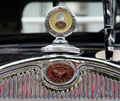| Industry | Automobile | |
|---|---|---|
| Fate | sold | |
| Founded | 1929 | |
| Defunct | 1946 | |
| Headquarters | Butler, Pennsylvania | |
| Products | Vehicles |
In 1935 the company was reorganized under the name American Bantam. Production resumed in 1937 and continued through 1941, including the first prototype of what later became the Jeep.
American Austin Car Company
The American Austin Car Company was founded in 1929, in Butler, Pennsylvania in premises that had belonged to the Standard Steel Car Company. Their intention was to assemble and sell in the United States a version of the Austin 7 car, called American Austin. After some initial success the Great Depression set in, and sales fell off to the point that production was suspended. In 1934 the company filed for bankruptcy.The automobile was designed in the hopes of creating a market for small-car enthusiasts in the United States. The cars had 747 cc inline-four engines and looked something like small Chevrolets with Stutz and Marmon-style horizontal hood louvres. The bodies were designed by Alexis de Sakhnoffsky and made by the Hayes Body Company of Detroit. The coupe was billed as a sedan, and sold for $445, slightly less than a Ford V8 roadster. The Great Depression made the cheaper secondhand cars more appealing, so sales dropped off.
More than 8000 cars were sold during the company's first (and best) year of sales, but sales fell off to the point that production was suspended in 1932. It restarted in 1934 with bodies now made in-house but stopped again between 1935 and 1937.
About 20,000 cars were produced.
From the 1960's the car gained a following with drag racers, who used them as base material for altereds. These were hybrid off-street driven hot rods and all out drag racing machines.
American Bantam
In 1935 Roy Evans, a former salesman for Austin, bought out the bankrupt company, which was reorganized under the name American Bantam. ("Bantam" is a smaller-bred version of any particular poultry breed — the name must have been chosen for the size of the automobiles that the company made.) The formal connection with UK Austin was severed, though a relationship was maintained. A series of changes was made to the American Austin car design, including a modified engine, and an exterior sheetmetal designed by Alexis de Sakhnoffsky.Production was resumed in 1937 and continued through 1941. Despite a wide range of Bantam body styles, ranging from light trucks to woodie station wagons, only about 6,000 Bantams of all types were produced.
American Bantam's 1938 model is famous for being the inspiration for Donald Duck's car.
Donald Duck's car was first seen on Don Donald (1937).
Original Jeep
American Bantam also pioneered the first Jeep to a design by Karl Probst, still with rounded fenders, and built 2765 of these (more than half of which went to The British Army and some sent on to Russia) after discontinuing the manufacture of passenger vehicles. Some of the motors and chassis were imported Toledo, OH; the bodies were made at the American Bantam Car factory in Butler, Pennsylvania.The company produced the most fuel-efficient engine and first prototype under the original tender specifications and was awarded the first contract, but because Willys Overland used a more powerful engine, and because elements favorable to Ford within the Quartermaster Corps claimed that Bantam lacked production capacity to produce the vehicle on the scale needed by the United States Department of War, the awarding of ongoing contracts was reopened. Eventually the U.S. Army gave the BRC (Bantam Reconnaissance Car) 40 designs to Willys-Overland and awarded the bulk of orders to Willys and Ford, while Bantam went on to produce Jeep trailers (T-3).









